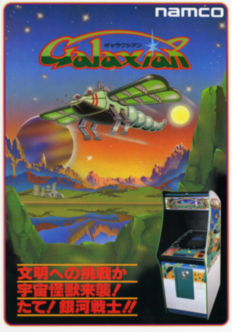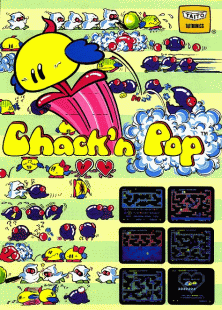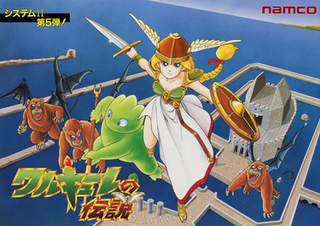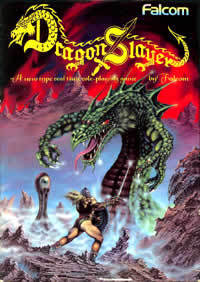
Galaxian is a 1979 fixed shooter arcade video game developed and published by Namco. The player assumes control of the Galaxip starfighter in its mission to protect Earth from waves of aliens. Gameplay involves destroying each formation of aliens, who dive down towards the player in an attempt to hit them.

Dig Dug is a maze arcade video game released by Namco in 1982. It was distributed in North America by Atari, Inc. The player digs underground tunnels to attack enemies in each level, by either inflating them to bursting or crushing them underneath rocks.

Xevious is a vertically scrolling shooter arcade video game developed and published by Namco in 1982. It was released in Japan by Namco and in North America by Atari, Inc. Controlling the Solvalou starship, the player attacks Xevious forces before they destroy all of mankind. The Solvalou has two weapons at its disposal: a zapper to destroy flying craft, and a blaster to bomb ground installations and enemies. It runs on the Namco Galaga arcade system.

Mappy is an arcade game by Namco, originally released in 1983 and distributed in the United States by Bally Midway. Running on the Namco's Super Pac-Man hardware modified to support horizontal scrolling, the game features a mouse protagonist and cat antagonists, similar to Hanna-Barbera's Tom and Jerry cartoon series. The name "Mappy" is likely derived from mappo (マッポ), a slightly pejorative Japanese slang term for policeman. The game has been re-released in several Namco arcade compilations. It spawned a handful of sequels and a 2013 animated web series developed by cartoonists Scott Kurtz and Kris Straub.

Pac-Land is a 1984 side-scrolling arcade platform game developed and released by Namco. It was distributed in North America by Bally Midway, and in Europe by Atari Games. Controlling Pac-Man, the player must make it to the end of each stage to return a lost fairy back to its home in Fairyland. Pac-Man will need to avoid obstacles, such as falling logs and water-spewing fire hydrants, alongside his enemies, the Ghost Gang. Eating large flashing Power Pellets will cause the ghosts to turn blue, allowing Pac-Man to eat them for points.

Whac-A-Mole is an arcade game. It was created in 1975 by the amusements manufacturer TOGO in Japan, where it was originally known as Mogura Taiji or Mogura Tataki.

Rally-X is a maze chase arcade video game developed in Japan and Germany by Namco and released in 1980. In North America, it was distributed by Midway Manufacturing and in Europe by Karateco. Players drive a blue Formula One race car through a multidirectional scrolling maze to collect yellow flags. Boulders block some paths and must be avoided. Red enemy cars pursue the player in an attempt to collide with them. Red cars can be temporarily stunned by laying down smoke screens at the cost of fuel. Rally-X is one of the first games with bonus stages and continuously-playing background music.

Chack'n Pop is a platform arcade game developed and released by Taito in 1984. In the game, the player controls a small yellow creature, Chack'n, with the objective being to retrieve hearts from a cave, all while avoiding the enemies contained within them. Chack'n also has the ability to deploy bombs, which can kill said enemies, which can bring bonuses depending on if all or none of the enemies have been killed.

Grobda is a 1984 multidirectional shooter arcade video game developed and published by Namco. It is a spin-off from Xevious, as the player's tank first appeared in that game as an enemy. It runs on Namco Super Pac-Man hardware but with a video system like that used in Mappy and The Tower of Druaga, and it also uses a DAC for the "Get Ready" speech sample at the start of each round.

Dragon Spirit is a 1987 vertical-scrolling shooter arcade game developed and published by Namco. In North America, it was distributed by Atari Games. Controlling the dragon Amur, the player must complete each of the game's nine areas to rescue the princess Alicia from the demon Zawell. Similar to Namco's own Xevious, Amur has a projectile weapon for destroying air-based enemies and a bomb for destroying ground enemies. It ran on the Namco System 1 arcade board.

Valkyrie no Densetsu is a 1989 action-adventure role-playing arcade game developed and published in Japan by Namco. It is a follow-up to the Family Computer game Valkyrie no Bōken (1986). Players control the warrior maiden Valkyrie and her lizard-like companion Kurino Xandra as they set out to drop a mythical item called the Golden Seed into the Northern Fountain to replenish the dying crop fields of Xandra Land. Gameplay involves defeating enemies and collecting gold to purchase magical spells and weapons in shops.

Dragon Slayer is an action role-playing game, developed by Nihon Falcom and designed by Yoshio Kiya. It was originally released in 1984 for the PC-8801, PC-9801, X1 and FM-7, and became a major success in Japan. It was followed by an MSX port published by Square in 1985, a Super Cassette Vision by Epoch in 1986 and a Game Boy port by the same company in 1990 under the name Dragon Slayer I. A version for PC-6001mkII was in development but was never released. A remake of Dragon Slayer is included in the Falcom Classics collection for the Sega Saturn.
Arcade Archives is a series of emulated arcade games from the late 1970s, 1980s, 1990s, and early 2000s for PlayStation 4, Xbox One, Microsoft Windows, and Nintendo Switch, published by Hamster Corporation. A sub-series called ACA Neo Geo focuses on re-releasing Neo Geo titles in their original arcade format, unlike many services that attempt to emulate the console versions.

LeMans is a single-player race game created by Atari, Inc. in 1976. It was distributed in Japan by Namco. It is the successor to the Gran Trak 10 and Gran Track 20 video games.

Cosmo Gang the Puzzle is a 1992 falling block puzzle arcade video game developed and published by Namco worldwide. The third game in its Cosmo Gang series, succeeding that year's Cosmo Gang the Video, players stack groups of blocks and aliens known as Jammers in a vertical-oriented well. The objective is to clear as many objects on the screen before they reach the top of the screen. Blocks are cleared by aligning them into complete horizontal rows, while Jammers are cleared by defeating them with blue-colored spheres.

Pro Baseball: Family Stadium, released as Pro Yakyū: Family Stadium in Japan and R.B.I. Baseball in North America, is a 1986 baseball video game developed and published by Namco for the Family Computer. In North America, it was published by Tengen as R.B.I. Baseball for the Nintendo Entertainment System. It was also released in arcades through the Nintendo VS. System. It is the first game in the Family Stadium and R.B.I. Baseball franchises. The game was a critical and commercial success in Japan and North America.
Hiroshi Ono was a Japanese video game artist. He spent most of his career at Namco and later Bandai Namco, designing pixel art and cabinet artwork for their arcade video games. Because of his focus and expertise on pixel art, he was nicknamed Mr. Dotman and The Wizard of Dot Art.
















